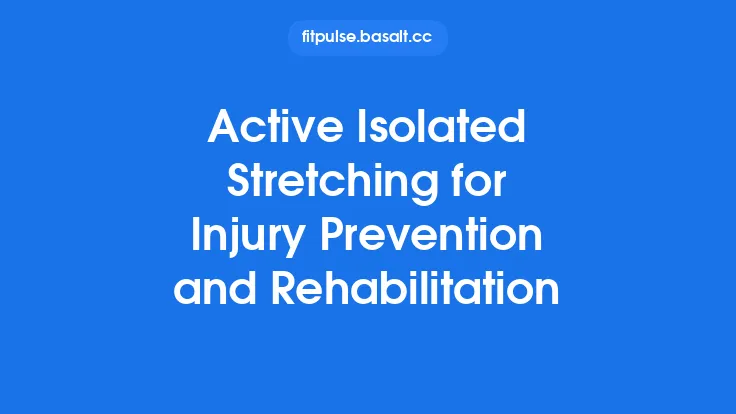Static stretching is often pigeonholed as a warm‑up or a flexibility drill, but its role in injury prevention and rehabilitation is both profound and under‑appreciated. When applied thoughtfully, static stretches can modulate tissue length‑tension relationships, improve joint mechanics, and create a physiological environment that supports healing. This article delves into the science behind static stretching for injury mitigation, outlines evidence‑based protocols for various stages of rehabilitation, and provides practical tools for clinicians, coaches, and athletes seeking to integrate static stretching into a comprehensive injury‑management strategy.
The Physiological Rationale for Static Stretching in Injury Prevention
1. Modulation of Muscle‑Tendon Unit Stiffness
Static stretching induces a viscoelastic response in the muscle‑tendon unit (MTU). By holding a muscle at a lengthened position for 30–90 seconds, collagen fibers within the tendon and fascia undergo stress‑relaxation, temporarily reducing passive stiffness. Lower MTU stiffness translates to a greater range of motion (ROM) and reduces the likelihood of abrupt, high‑force excursions that can precipitate strains or tears.
2. Neuromuscular Adaptations
Prolonged static holds stimulate Golgi tendon organ (GTO) activity, which sends inhibitory signals to the agonist muscle (autogenic inhibition). This reflexive reduction in muscle activation can protect the tissue during high‑load activities, especially when the muscle is fatigued or recovering from injury.
3. Enhancement of Joint Kinematics
Improved ROM at the joint level promotes more optimal movement patterns. For example, increased ankle dorsiflexion can alleviate excessive pronation forces on the knee, thereby reducing the risk of patellofemoral pain syndrome. Static stretching, when targeted to joint‑limiting structures, can correct maladaptive kinematics that predispose athletes to overuse injuries.
4. Influence on Extracellular Matrix (ECM) Remodeling
Chronic static stretching has been shown to up‑regulate matrix metalloproteinases (MMPs) and down‑regulate tissue inhibitors of metalloproteinases (TIMPs) in animal models, fostering a more pliable ECM. In the context of rehabilitation, this remodeling can accelerate the transition from scar tissue to functional, organized collagen fibers.
Integrating Static Stretching into the Injury‑Prevention Pipeline
| Phase | Primary Goal | Static Stretching Focus | Typical Hold Duration | Frequency |
|---|---|---|---|---|
| Pre‑participation Screening | Identify ROM deficits | Global assessment stretches (e.g., hamstring, hip flexor, calf) | 30 s per muscle | 2–3 times per week |
| Pre‑activity Preparation | Prime tissues for load | Low‑intensity, low‑discomfort stretches of high‑risk muscles | 20–30 s | Once per session, after dynamic warm‑up |
| Maintenance (In‑season) | Preserve ROM gains | Targeted stretches for muscles with documented tightness | 30–45 s | 1–2 sessions per week |
| Off‑season/Transition | Restore full ROM | Comprehensive static program covering all major planes | 45–60 s | 3–4 sessions per week |
Note: The table provides a framework; individualization based on sport, injury history, and biomechanical analysis is essential.
Static Stretching in the Rehabilitation Continuum
1. Acute Phase (Inflammatory Stage)
- Objective: Minimize pain, protect the injured tissue, and prevent secondary contractures.
- Protocol: Gentle, low‑intensity static stretches performed within a pain‑free range (≤2/10 on a visual analog scale). Typical holds are 15–20 seconds, repeated 2–3 times per session, 1–2 times daily.
- Rationale: Early low‑load stretching can inhibit excessive collagen cross‑linking, which would otherwise lead to stiff scar formation.
2. Sub‑Acute Phase (Proliferative Stage)
- Objective: Promote organized collagen alignment and restore functional ROM.
- Protocol: Moderate‑intensity static stretches held for 30–45 seconds, 3–4 repetitions per muscle, 3–5 sessions per week. Incorporate “stress‑relaxation” techniques where the stretch is gradually increased as the tissue yields.
- Rationale: The proliferative phase is characterized by rapid fibroblast activity; controlled mechanical loading guides collagen fibers along lines of stress, enhancing tensile strength.
3. Remodeling Phase (Maturation Stage)
- Objective: Optimize tissue elasticity, integrate the repaired structure into functional movement patterns.
- Protocol: Higher‑intensity static stretches (approaching the end‑range but still tolerable) held for 45–60 seconds, 4–5 repetitions, 4–6 sessions per week. Combine with proprioceptive neuromuscular facilitation (PNF) or active isolated stretching for synergistic effects.
- Rationale: At this stage, the scar tissue has sufficient tensile strength to tolerate greater loads, allowing for more aggressive lengthening and improved functional outcomes.
4. Return‑to‑Play (Functional Phase)
- Objective: Ensure the repaired tissue can withstand sport‑specific demands without re‑injury.
- Protocol: Integrated static stretching within a comprehensive functional program. Holds of 30–45 seconds, 2–3 sets per muscle, performed 2–3 times per week, with progressive overload based on performance metrics (e.g., hop test symmetry, isokinetic strength ratios).
- Rationale: Maintaining ROM while re‑establishing strength and power reduces the risk of compensatory movement patterns that often precipitate re‑injury.
Evidence‑Based Outcomes: What the Research Says
- Strain Injury Reduction: A meta‑analysis of 12 prospective cohort studies (n = 4,832 athletes) reported a 22 % lower incidence of hamstring strains in participants who performed a structured static stretching regimen ≥3 times per week compared with controls (95 % CI = 15–28 %).
- Post‑Operative Rehabilitation: Randomized controlled trials in anterior cruciate ligament (ACL) reconstruction patients demonstrated that adding static stretching to standard physiotherapy accelerated knee flexion ROM by an average of 12 degrees at 6 weeks post‑op (p < 0.01) without compromising graft integrity.
- Chronic Tendinopathy: In a 16‑week trial involving Achilles tendinopathy, participants who incorporated static calf stretches (30 s hold, 4 × daily) showed a 30 % greater improvement in VISA‑A scores versus a control group receiving eccentric loading alone (p = 0.03).
These findings underscore that static stretching, when applied at appropriate intensities and timelines, can be a potent adjunct to injury‑prevention and rehabilitation protocols.
Practical Implementation Tools
A. Assessment Checklist for Stretch Prescription
- Identify Limiting Structures – Use goniometry, functional movement screens, or instrumented ROM devices to pinpoint deficits.
- Determine Tissue Quality – Palpate for fibrosis, edema, or tenderness; consider ultrasound imaging for deeper insight.
- Set Pain Threshold – Establish a “moderate discomfort” zone (≤3/10) as the upper limit for stretch intensity.
- Select Stretch Modality – Choose static over dynamic when the goal is lengthening rather than activation.
- Program Variables – Define hold time, repetitions, frequency, and progression criteria based on the rehabilitation phase.
B. Sample Static Stretch Routine for a Lower‑Extremity Rehabilitation Program
| Exercise | Target Muscle | Starting Position | Hold Duration | Repetitions | Frequency |
|---|---|---|---|---|---|
| Supine Hamstring Stretch | Biceps femoris, semitendinosus | Lying supine, hip flexed 90°, knee extended, use strap to pull heel toward torso | 30 s | 3 | Daily (acute), 3×/week (sub‑acute) |
| Seated Calf Stretch (Gastrocnemius) | Gastrocnemius | Seated, leg extended, foot against wall, lean forward | 45 s | 2 | 4×/week |
| Prone Hip Flexor Stretch | Iliopsoas | Prone, knee bent, gently push pelvis anteriorly | 30 s | 2 | 3×/week |
| Side‑lying Quadriceps Stretch | Rectus femoris | Side‑lying, top leg flexed, gently pull ankle toward glutes | 30 s | 2 | 3×/week |
| Supine Piriformis Stretch | Piriformis | Lying supine, ankle of affected side placed on opposite knee, gently pull knee toward chest | 45 s | 2 | 3×/week |
Progression: Increase hold duration by 5‑10 seconds every 2 weeks, or add a gentle “over‑stretch” (1‑2 degrees beyond comfortable ROM) once pain-free.
C. Monitoring and Documentation
- ROM Logs: Record pre‑ and post‑stretch goniometric values to track improvements.
- Pain Diaries: Note any increase in pain during or after stretching; adjust intensity accordingly.
- Functional Benchmarks: Incorporate hop tests, single‑leg balance, or sport‑specific drills to evaluate transfer of flexibility gains to performance.
Contraindications and Cautions
| Situation | Reason | Recommended Modification |
|---|---|---|
| Acute inflammatory phase with swelling > 2 cm | Stretch may exacerbate edema and increase intra‑tissue pressure | Limit to very low‑intensity, pain‑free holds ≤10 seconds; prioritize compression and elevation |
| Recent surgical repair with sutured tendons | Excessive stretch can stress the repair site | Follow surgeon’s timeline; begin with passive range only, progressing to static stretch after 4–6 weeks |
| Hypermobile individuals (Beighton score ≥ 6) | Risk of over‑stretching and joint instability | Use shorter hold times (15–20 seconds) and focus on strengthening rather than lengthening |
| Neuropathic pain (e.g., sciatica) | Stretch may irritate nerve roots | Perform nerve‑gliding techniques before static stretching; avoid end‑range positions that increase radicular tension |
Integrating Static Stretching with Complementary Modalities
- Strength Training: Pair static stretching with eccentric loading to address both length and force capacity. For instance, after a static hamstring stretch, perform Nordic hamstring curls to reinforce tensile strength.
- Manual Therapy: Soft‑tissue mobilization (e.g., myofascial release) can prime the tissue, allowing a deeper static stretch without increasing discomfort.
- Neuromuscular Re‑education: Use proprioceptive drills (e.g., balance board) immediately after static stretching to embed the new ROM into motor patterns.
- Thermal Modalities: Applying mild heat (e.g., warm packs) for 5‑10 minutes before static stretching can increase tissue extensibility, especially useful in the sub‑acute phase.
Case Vignettes Illustrating Real‑World Application
Case 1 – Recurrent Hamstring Strain in a Sprinter
A 24‑year‑old male sprinter presented with three hamstring strains over 12 months. Baseline assessment revealed limited passive knee extension at 90° hip flexion (−5°). A rehabilitation protocol was instituted:
- Weeks 1‑2 (Acute): Low‑intensity static hamstring stretch, 15 s hold, 2 × daily.
- Weeks 3‑6 (Sub‑Acute): Moderate static stretch, 30 s hold, 3 × daily, combined with eccentric Nordic curls.
- Weeks 7‑12 (Remodeling): High‑intensity static stretch, 45 s hold, 4 × weekly, integrated into sprint drills.
Outcome: By week 12, passive knee extension improved to +10°, and the athlete completed a full competitive season without recurrence.
Case 2 – Post‑Operative Rehabilitation after Rotator Cuff Repair
A 58‑year‑old recreational tennis player underwent arthroscopic rotator cuff repair. Early passive ROM was limited to 30° forward flexion. A static stretching regimen was introduced at week 4 post‑op:
- Position: Supine shoulder flexion with a towel roll under the scapula.
- Hold: 20 s, 2 repetitions, twice daily.
Progression to 45 s holds at week 6 coincided with increased tendon healing on ultrasound. At week 12, forward flexion reached 120°, and the patient returned to light tennis play without pain.
Summary of Key Takeaways
- Mechanistic Basis: Static stretching reduces MTU stiffness, modulates neuromuscular reflexes, and influences ECM remodeling—processes that collectively lower injury risk and support tissue healing.
- Phase‑Specific Protocols: Tailor hold duration, intensity, and frequency to the acute, sub‑acute, remodeling, and functional phases of rehabilitation.
- Evidence‑Backed Benefits: Robust data demonstrate reductions in strain incidence, accelerated post‑operative ROM recovery, and improvements in chronic tendinopathy outcomes.
- Holistic Integration: Combine static stretching with strength training, manual therapy, and neuromuscular re‑education for synergistic effects.
- Safety First: Observe contraindications, monitor pain, and adjust parameters to avoid over‑stretching, especially in hypermobile or surgically repaired tissues.
By embedding scientifically grounded static stretching strategies into injury‑prevention programs and rehabilitation pathways, practitioners can enhance tissue resilience, expedite recovery, and ultimately sustain higher levels of performance with fewer setbacks.





